Business
Plaze Review: Philly’s Fastest Growing DIY Networking App
Published
3 years agoon

I’ve been involved with do-it-yourself music in the Greater Philadelphia area for over a decade now. Throughout this time, I have occupied every potential role: showgoer, performer, promoter, you name it.
The groups I’ve ended up with typically share a similar genesis.
Here’s a picture: you’re sitting in a half-empty living room. Below you, a crowded basement pulses with tame tropes and half-hearted expressions. Some loudmouth nursing a 40oz foolishly exchanges charm for pretension and out from a groggy, smoke-induced stupor, an assertion springs: “Jawbreaker is the definitive Bay-Area rock band of the 90s. Miss me with that Green Day sh*t.”
Leaping (or staggering) to your feet, you fumble for rejoinders. It’s then that you find yourself thrust into a spirited dialogue with an equally impassioned stranger.
One thing leads to another. Chatting and chain-smoking, you trade visions, earnestly planning a potential project only to wake up the next morning without energy or interest in maintaining contact. After all, they smoked menthols— and your inner pre-teen still weeps to Green Day. You don’t need that kind of energy in your life.
The story repeats itself ad nauseam and there’s no light at either end of the tunnel.
Enter: Plaze. Philadelphia’s hottest DIY networking app. Aiming to revamp the way musicians discover one another, Plaze offers a digital alternative to the oft-excruciating process of starting a band.
What is Plaze?
Before I dig in, let me provide some background about Plaze. Like most innovations, Plaze was inspired by a problem. As stated in the first sentence of the Our Story portion on their website: “Plaze started with a problem.”
Call it journalistic intuition.
Co-founder Jamie Mallia, a drummer, recounts his story. It’s a common one, and we all have our own version. An exciting new musical partnership abruptly halted upon the realization that the person you have agreed to jam with is, shall we say, grossly incompetent.
Naturally, the unevenness of their skillset led to an awkward, short-lived alliance. That’s when the big idea hit: an app that facilitates discovery among creatives. One that promotes networking and collaboration while helping weed out the mismatches.
Plaze looks to one-up other avenues of creative networking like Facebook and Reddit. It does so by tailoring the experience to the expressed needs of its users. It is, however, currently a Philadelphia-centric app.
A New Way of Networking
For the sake of transparency, I must share my initial skepticism. And I’ll be the first to admit that this is likely the result of my reverence for the punk ethos. But honestly, that’s a stuffy holdover.
And punk, in its truest and most essential form, is about moving forward. Embracing change, even (and especially) when it threatens tradition. The fruits of punk that have prevailed throughout history have been those that, in threatening tradition, offers a constructive, democratic alternative. And so, with that renewed understanding in mind, I’m downloading Plaze.
Nowadays, there’s an app to help you with everything from grocery delivery services to keeping your mental health in check. So, really, why shouldn’t there be an app for meeting other local creatives?
Mind you, this article will encapsulate one person’s attempt at using the app.
My experience doesn’t speak for the whole of us. Everyone who uses this app, with their own style, expectations, intentions, and skill sets will undoubtedly yield a unique experience. With any hope, anyway.
In a sense, you can consider this less of a review and more of an account. The semantic difference is that, in this case, I won’t submit an official judgment.
How’s the User Interface?
Upon downloading Plaze, you’ll find that the interface is simple and intuitive. For those of us experienced with any of those countless dating apps, it’s downright familiar. This isn’t a dating app though, so there’s some hope for you yet. Just think of all the time you’ll save not having to worry about a punchy new pick-up line.
Features
All of the features are offered in a palatable four-tab menu. The tabs are as follows:
Profile
My Scene
Map
Explore
Profile

You’re going to want to add a picture or two. Really flesh out your profile here. Honestly, this function alone is pretty dope. Consider it a central hub for all of your artist profile pages. Now you can have your Bandcamp, Spotify, Facebook, Instagram, Youtube, and personal website all in one place. Artists are not terribly well-known for being, well, unlazy— so this certainly helps the discovery process along!
The profile section is also where you’ll outline your skillset. Shameless promotion here, but I need to show photos to properly explain.
This also provides me the opportunity to show off this sleek, seamlessly navigable interface. Despite being a millennial, my handling of most new technology is more in line with that of a 100-year-old man. But believe you me, sonny: this app is absolutely easy to handle. Golly!
You can write up a quick blurb about yourself and add all of your skills. This includes both on-stage and off-stage skills; which means audio engineers, promoters, teachers, and photographers all have a place in Plaze.
Whatever your niche, Plaze has thought of ways to plug it into the scene. Speaking of the scene, let’s hop to the next tab.
My Scene
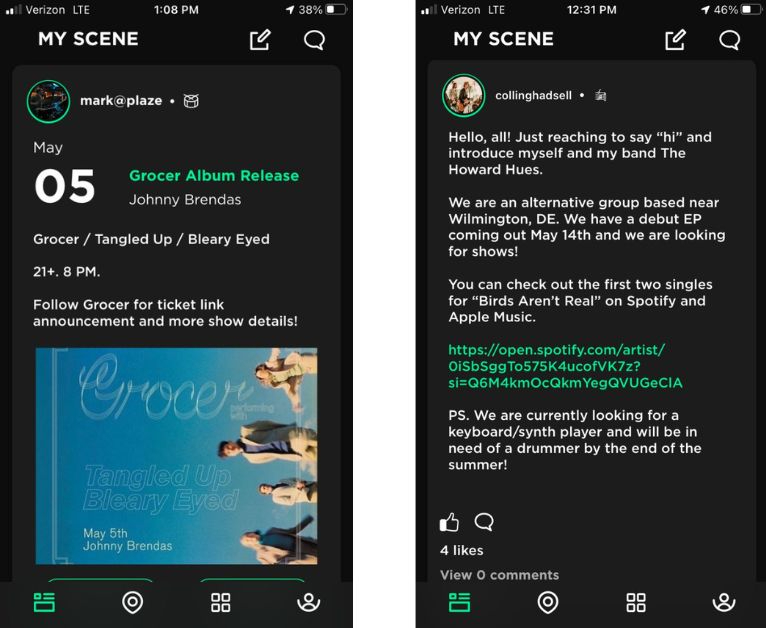
This function puts you in the same room as what’s happening in your area. At all times. The page is split up into two subsections, both of which are very simply laid out: Show Posters and Community. These sections borrow a lot of the convenient aspects of Facebook or Reddit.
Show Posters, as its name suggests, is purely a feed for flyers. It’s like an infinite scroll of calendar events for upcoming shows. You can interact with these the same way you would Facebook events, including RSVPs, comments, and likes.
Community is a collection of threads, not unlike Reddit, where people can post about any number of things. Want to promote an upcoming album release? Need a new drummer? Maybe you’re a promoter in search of an opening act. Whatever your need, this section allows you the freedom to express it.
Anyone can make a show flyer or community post!
Map
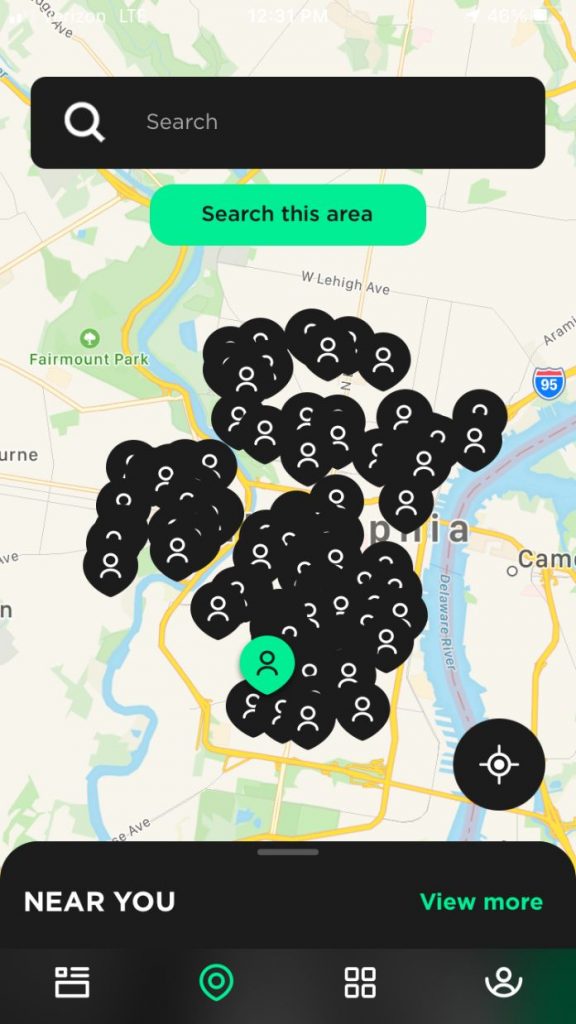
The map function essentially contextualizes people’s profiles in a geographic layout. This is a cool feature, but its benefits are limited to showing exactly where each individual profile is. It’s a helpful tool, nonetheless.
Explore
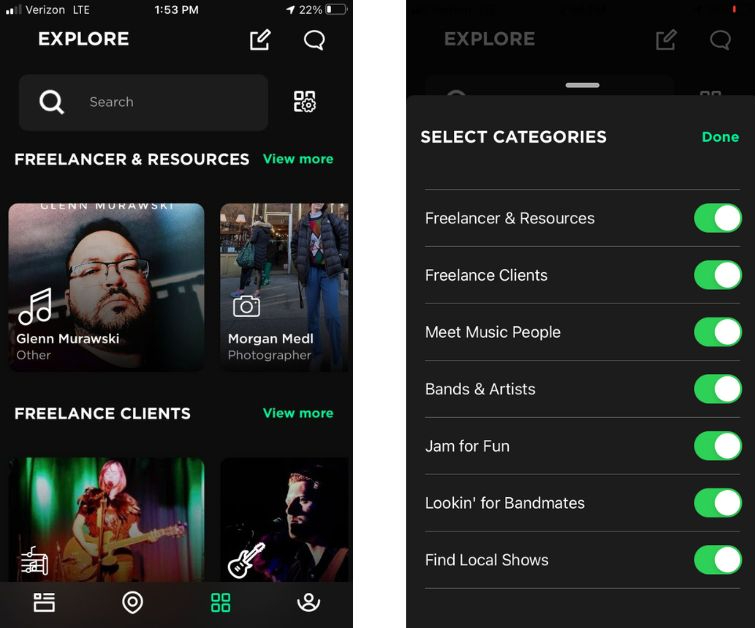
This page contains the meat and potatoes of the app. It provides full access to all other profiles on Plaze. A search bar at the top of the page offers a speedy look-up for specific people. Or you can scroll along casually, thumbing through profiles of Plaze users. (Plazers? Plazeers?)
To make it even more convenient, it splits up profiles into different categories based on each user’s expressed intent. Here are some of the subsections: Freelance Clients, Lookin’ For Bandmates, Jam For Fun, Find Local Shows, and Near You. It’s as simple as sending a message. From there, you’re free to discuss as you please! You can even curate your own feed, narrowing it down to your specific need.
Closing Thoughts: Is Plaze worth it?
Plaze offers an entirely free platform for exploring your scene. You stand to lose nothing, and the gains are immeasurable. it’s not limited to musicians, either. Plaze is perfect for artist-designers, audio engineers, promoters, podcasters, videographers, and journalists. Every creative personality is capable of offering (and monetizing) their skills with this app.
The most inspiring part of Plaze is the way it injects a burst of democracy into an experience historically fraught with crossed arms, naysayers, and gatekeepers. Gone are the days of not being able to find the right band members. And never again will you be burdened with the task of having to cold message a show promoter on Instagram, only to be left on read time and time again.
I can speak from experience regarding the difficulties of finding something as seemingly common as a good photographer. You end up just asking a friend with a camera and, oftentimes, you’re underwhelmed with the final product. With Plaze, freelancers are provided a large pool of potential clients and vice versa.
Just like every punk-rocker has a conversion story— a discovery of new, challenging, artistic integrity in the face of an otherwise bland, corporate landscape— so too may every DIY soul be converted into a Plaze-user (Plazite? Plazian? I hate this bit) and reimagine the possibilities of local art.
Even if they don’t f*ck with Green Day.
You may like
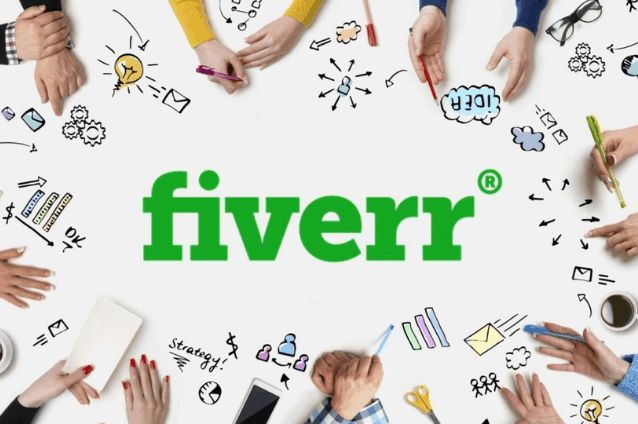
TL;DR: Penji leads Fiverr alternatives for businesses needing consistent design work at $499/month. Designjoy offers premium creative direction at $5,995/month. ManyPixels provides affordable, unlimited design at $549/month. Dribbble connects you with portfolio-vetted designers. Behance gives access to Adobe’s creative network.
Best Fiverr Alternatives:
- Penji: Unlimited designs for $499/month with US-based designers
- Designjoy: Premium subscription service at $5,995/month
- ManyPixels: Budget-friendly unlimited design at $549/month
- Dribbble: Direct access to portfolio-vetted designers
- Behance: Adobe’s creative network for finding talent
Why Are Business Owners Leaving Fiverr?
Some business owners find it difficult to search through numerous Fiverr profiles to find reliable designers. Frequently cited concerns include inconsistent quality, communication issues, and designers discontinuing work before completion.
Alternative freelance design platforms have emerged. Some platforms verify their designers, provide transparent pricing, and aim for reliable results. Here are services that support business needs.
Which Platforms Actually Work for Business Owners?
Penji: Best Value for Business Owners

For $499 per month, businesses can submit multiple design requests without worrying about extra charges or negotiating prices. This option provides consistent graphic design support as needed.
Penji connects you with US-based designers who know your industry. They handle everything from social media graphics and presentations to logos and print materials. Most projects are completed in 24 to 48 hours, and you can request as many changes as you need. You can also pause your subscription whenever you want, which is helpful for businesses with changing needs.
Designjoy: Best for Premium Creative Work
Businesses seeking premium creative direction may consider Designjoy at $5,995 per month. Designers often bring experience with major brands. The service includes design quality, easy revisions, and a focus on thoughtful creative work.
ManyPixels: Best Budget Subscription Option
ManyPixels charges $549 per month for unlimited design requests. Their team is global, so projects usually take 48 to 72 hours, compared to Penji’s faster turnaround. This is a good fit for marketing teams that need many designs, such as ads, email headers, or social media templates.
Dribbble: Best for Finding Portfolio-Vetted Talent
Dribbble began as a platform for designers to display their work. Clients can contact designers directly for freelance or contract opportunities. Rates typically range from $50 to $300 per hour and are set between client and designer. The platform allows portfolio reviews before contact and does not charge additional platform fees.
Behance: Best for Adobe Creative Professionals
Behance is Adobe’s creative network where thousands of designers share their portfolios. You can’t hire designers directly through the site, but it’s a great place to find talent and contact them by email or LinkedIn. Many designers include their availability and contact details on their profiles, so it’s simple to get in touch.
How Do You Choose What Fits Your Business?
Penji offers both quality and cost considerations: access to US-based designers, fast turnaround, and unlimited requests are standard. Learn more about why businesses prefer Penji over traditional freelance marketplaces.
Designjoy may be suitable for businesses in markets where design quality is important for branding. ManyPixels can be an option for those prioritizing budget and adaptability over turnaround speed. See how Penji compares to Fiverr in terms of quality and reliability.
Ready to Stop Settling for Unreliable Design?
Businesses may benefit from exploring Penji’s subscription service to determine if reliable, high-quality design solutions meet their requirements. Browse through examples of completed projects to see the quality you can expect.
Frequently Asked Questions
Which Fiverr alternative is best for small business owners?
Penji works best for most small businesses because $499/month is affordable and includes unlimited design work. You avoid the time drain of managing freelancers while getting consistent quality. Only go premium (Designjoy) if your market demands it.
Can I pause these subscriptions if I don’t need design every month?
Yes. Penji, ManyPixels, and Designjoy all let you pause at any time. You only pay for months when you’re actively using the service, making it practical even for businesses with seasonal needs or unpredictable design requirements.
What types of design work do these platforms handle?
Penji covers logos, social media graphics, presentations, print materials, web design mockups, and packaging. Designjoy handles similar work plus strategic brand development. ManyPixels focuses on digital marketing assets. Most platforms handle everything except complex web development or animation.
How do subscription services compare to hiring a full-time designer?
A full-time designer costs $50,000-80,000 annually plus benefits. Penji runs $5,988/year with more flexibility. You get similar output without payroll overhead, equipment costs, or downtime when there’s no work. Plus, you can pause between busy periods.
Are the designers actually based in the US?
Penji uses US-based designers who understand American business culture and time zones. ManyPixels works with a global team across different time zones. Designjoy features experienced US designers. If location matters for communication and cultural fit, check each platform’s designer location before committing.

TLDR: Penji and Kimp do flat rate unlimited design (Kimp throws video in, too). ManyPixels is cheaper for digital assets and Designity is premium US-based creative direction for more complex projects.
These Superside alternatives made the cut, and a few stand apart from the rest. While there are relative pros and cons to each worth delving into, the features that matter most to your team and company goals will define what’s best for you. Here’s a shortlist of what stands out.
1 Penji
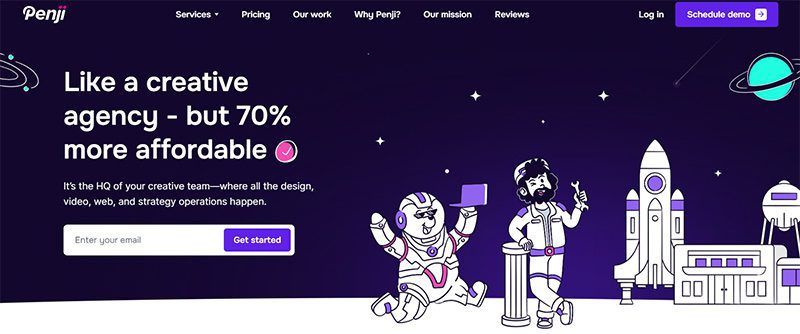
Penji is one of the best superside alternatives. It claims to be the simple graphic design subscription solution you need. With flat-rate pricing, it’s successful through its workforce acquisition efforts as they only hire the top 2% of designers worldwide, meaning there’s always a crew ready to take and execute reliable assignments from social graphics to print needs. Furthermore, they have a clean feedback process and queue meaning that marketing teams can rely on a sound platform solution that delivers over time for ongoing launches or efforts for foundational power.
Pros:
- Unlimited requests and revisions.
- Designers are dedicated, meaning they get to know the brand over time.
- Can do everything from web needs to print, advertising, and decks.
- Flat pricing makes budgeting easy for internal chargebacks.
Cons:
- The fastest turnaround time requires an upgrade.
2 ManyPixels
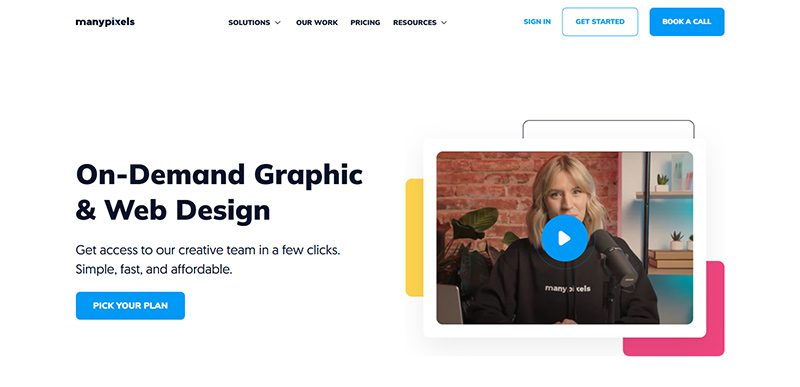
ManyPixels is one of the top up-and-coming Solutions thanks to ease of use and lower starting pricing. ManyPixels is a good choice for those companies that primarily need digital graphic assets and want something that’s easy to scale. It also includes motion and video editing, which makes it more versatile in its outputs as the plans increase.
Pros:
- Low starting prices are one of the lowest for entry-level efforts.
- Access to all digital and print graphic design.
- A dedicated design portal helps keep things clean.
- Can easily pause or cancel a subscription.
Cons:
- Higher plans include UI/UX and more extensive offerings.
- Important requests may take longer based on the request type.
- May be less strategic than an agency would be.
3 Kimp

For anyone with visually-driven campaigns on social media and web properties, Kimp believes it specializes in unlimited graphic design plus unlimited video design, thus allowing for easy access to motion graphics needs at a flat-rate subscription price. This is especially effective for companies looking to have the Graphics + Video combo.
Pros:
- The Graphics + Video combo plan is a unique offering.
- Team of dedicated graphic designers and video editors.
- Combines branding efforts through Canva and motion graphics needs.
- 7-day risk-free trial.
Cons:
- It’s not recommended for niche-specific designs (like UI/UX or web development).
- There are hard limits per project and queue requests.
- The price for video or combo plans are higher.
4 Designity

Finally, Designity operates as a managed service where a Creative Director is assigned to the customer who manages a team of domestic creatives who are specialists in their field (for designs, animations, etc.). This allows for more quality assurance from a domestic stance in a strategic alignment offering more creative accountability than online-only, ticketed request platforms like others.
Pros:
- Dedicated U.S.-based Creative Director runs requests.
- U.S.-based creative services mean sensitive brand work is safe.
- Great for complicated projects that need time and oversight.
- The full-service platform includes design, video, and animation.
Cons:
- Higher costs due to managed U.S.-based efforts.
- Takes longer than it’s worth for basic accountability measures.
- Only mid-market to enterprise offerings will make sense here due to costs.
Business
What are the Best Canva Alternatives for Designers and Marketers?
Published
3 days agoon
October 23, 2025
Many marketers love Canva as it allows them to create stunning graphics easily and affordably. In addition, it is also a favorite tool among many professional designers. However, Canva is one tool that many marketers and designers outgrow, thanks to its limitations. If you’re looking for the best Canva alternatives, here is our list of the top five:
Penji

A graphic design subscription platform, Penji, is the best Canva alternative for all business sizes. It offers unlimited graphic design services and revisions done by top-caliber designers. In as little as 24 to 48 hours, you’ll get your designs, reducing the risks of design bottlenecks and delays. All these for a flat rate, starting at $499 per month.
RelayThat

Looking for the best Canva alternative that offers design automation? RelayThat is the design partner you need. It can generate numerous branded visuals instantly, allowing you to get bulk designs quickly. Its key features include brand management, headline generator, one-click resize, and over 3 million free images.
VistaCreate

Previously known as Crello, VistaCreate is an excellent option for social media graphics, posters, and other marketing materials. It has an interface similar to Canva, making it an easy-to-use alternative. It also offers animated templates, a drag-and-drop editor, and print services through VistaPrint.
Stencil

Claiming to be “The Web’s Favorite Online Graphic Design Tool,” Stencil is an easy-to-use alternative to Canva. It offers a low learning curve, making it ideal for small teams, startups, bloggers, and social media managers. This tool lets you whip up blog headers, ad creatives, and other visual assets quickly.
Design Wizard

A powerful image and video editing tool, Design Wizard enables you to create both static and animated content. It offers a comprehensive template library that you can edit for all your design needs. It has a low learning curve, thanks to its beginner-friendly interface.

What’s the Best Fiverr Alternatives?

What’s the Best Superside Alternatives today?

What are the Best Canva Alternatives for Designers and Marketers?
What’s the Best Design Pickle Alternative?

Top Marketing Podcasts for 2025 You Should Be Following Today

What are the Best Social Media Post Design Services for Startups?

What’s the Best Package Design Service Agency?

Top Marketing Podcasts for 2025 You Should Be Following Today

What’s the Best Package Design Service Agency?
What’s the Best Design Pickle Alternative?

What are the Best Social Media Post Design Services for Startups?

What are the Best Canva Alternatives for Designers and Marketers?

What’s the Best Superside Alternatives today?




